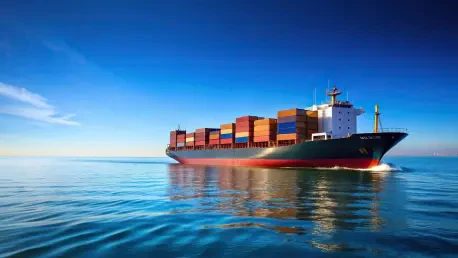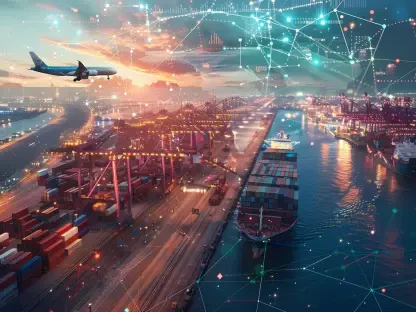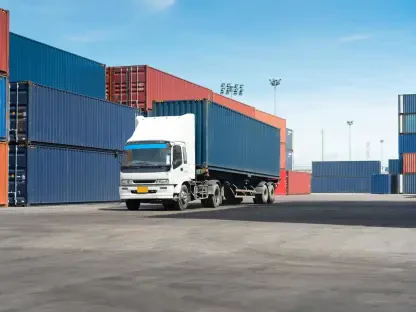In a world where global trade hinges on the efficiency of critical maritime routes, the Suez Canal stands as a vital lifeline, channeling nearly 12% of the planet’s trade volume. Recent data reveals a striking resurgence in ship traffic through this historic waterway, with October recording the highest number of transits in nearly two years at 229 vessels. This uptick sparks curiosity: is the canal reclaiming its indispensable role in international commerce amid persistent regional challenges? This roundup gathers insights from industry stakeholders, shipping experts, and economic analysts to explore the canal’s recovery, the hurdles it faces, and its future in shaping trade dynamics. The discussion aims to provide a comprehensive view of whether this iconic route can restore trust and stability for global shipping.
Diverse Perspectives on the Canal’s Recovery
Traffic Surge: A Beacon of Hope or Fragile Growth?
Industry reports highlight a significant 10% increase in tonnage through the Suez Canal from July to October compared to the prior year, despite only a modest 2% rise in ship numbers. Many shipping analysts view this as a promising sign, suggesting that larger vessels are returning, reflecting renewed confidence among carriers. The emphasis on bigger ships transiting the canal points to a potential shift in strategy for companies seeking to optimize costs and transit times.
However, not all opinions align on the durability of this growth. Some logistics consultants caution that the recovery remains fragile, with certain carriers hesitant to fully commit due to lingering uncertainties in the region. They argue that while the numbers are encouraging, a deeper look reveals that the volume is still below pre-crisis levels, raising questions about long-term stability.
A contrasting perspective from maritime data trackers emphasizes the strategic efforts behind this resurgence. Initiatives by canal authorities to promote trial voyages and rebuild trust have garnered attention, with many in the sector noting that these proactive steps could solidify the upward trend if sustained. This viewpoint underscores the importance of consistent policy support in maintaining momentum.
Shipping Giants Weigh In: Cautious Optimism
Major shipping companies offer a spectrum of opinions on resuming operations through the canal. Representatives from leading firms like CMA CGM and Hapag-Lloyd express cautious optimism, pointing to recent transits of mid-sized vessels, such as 17,000-TEU ships under naval escort, as a testing ground. They suggest that if regional stability holds, plans to increase voyage frequency could materialize swiftly, cutting down on detours around the Cape of Good Hope.
On the flip side, some fleet operators remain reserved, particularly about deploying their largest vessels, like 23,000-TEU carriers. Industry insiders note that the balance between the canal’s shorter route and the risks tied to regional instability continues to influence decision-making. This hesitation reflects a broader sentiment of weighing efficiency against potential disruptions.
A third angle comes from shipping association members who highlight the role of collaborative security measures, such as naval escorts, in encouraging returns. They argue that these protective efforts signal a commitment to safety, which could tip the scales for more companies to rejoin the route. Their perspective focuses on the potential for partnerships to address lingering doubts among carriers.
Economic Hurdles: The Insurance Cost Debate
One of the most discussed barriers to a full recovery is the steep rise in marine insurance costs for Red Sea transits. Risk management advisors widely agree that these elevated premiums pose a significant deterrent, impacting smaller shipping lines more acutely than larger conglomerates. The financial strain creates an uneven playing field, where cost considerations often outweigh the benefits of a shorter route.
Economic analysts provide a different lens, suggesting that insurance costs are only part of a broader puzzle. They point to regional instability as a compounding factor, arguing that without addressing the root causes of risk, financial burdens will persist. This viewpoint calls for a holistic approach, combining economic relief with geopolitical solutions to ease the burden on shipping firms.
A smaller but vocal group of trade consultants challenges the narrative that insurance costs are an insurmountable obstacle. They propose that innovative risk-sharing models or international subsidies could mitigate expenses, drawing from past examples in other high-risk corridors. Their input adds a layer of possibility to the conversation, suggesting actionable ways to navigate this economic challenge.
Strategic Initiatives: Building a Reliable Future
Feedback on the Suez Canal Authority’s efforts to restore confidence reveals a generally positive outlook. Maritime policy experts commend the introduction of incentives for trial voyages and partnerships with naval forces to ensure safer passage. These measures are seen as critical steps toward positioning the canal as a dependable option for global trade, especially after prolonged disruptions.
Shipping industry veterans offer a comparative analysis, noting similarities between current recovery patterns and historical crises. They suggest that while past rebounds took time, sustained security improvements often led to rapid trade normalization. This historical context provides a benchmark for gauging whether today’s initiatives can outpace ongoing geopolitical and economic headwinds.
A forward-looking perspective from trade strategists emphasizes the canal’s potential to reshape regional commerce if stability is achieved. They speculate that long-term investments in infrastructure and security could elevate the canal beyond its pre-crisis status, making it a cornerstone of future trade routes. This optimistic take hinges on the alignment of international efforts to support the canal’s ambitions.
Key Takeaways from the Roundup
Reflecting on the insights gathered, it becomes clear that the Suez Canal’s recovery stirs a mix of optimism and caution among stakeholders. The 10% tonnage surge and the return of larger vessels mark significant progress, yet high insurance costs and regional risks temper enthusiasm. Differing views on traffic growth, shipping giant hesitancy, and economic barriers paint a complex picture of a waterway at a crossroads. Strategic moves by authorities earn praise, though their long-term impact remains a point of debate. For those navigating this evolving landscape, monitoring regional developments and advocating for international cooperation in securing the Red Sea emerge as practical next steps. Exploring innovative solutions to mitigate insurance costs also stands out as a vital consideration to support the canal’s journey toward reclaiming its pivotal role in global trade.









